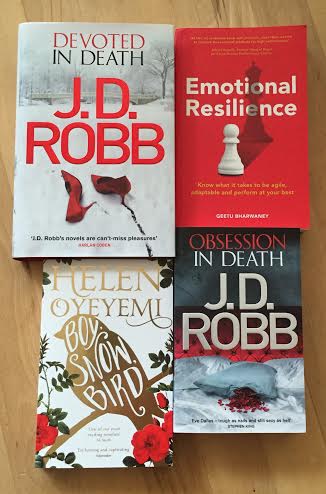Geetu Bharwaney Emotional Resilience.
An intelligent and accessible book. This brilliant book helps you develop your emotional resilience. It has practical steps which are easy to follow and understand, leaving you with the tools to perform at your best. It is all broken down well and is an original, unique book that allows you to prepare yourself against challenging situations. This great book gives you the toolkit to be your best at work.
Pressure, stress and annoying problems are all part of life, especially at work.
By developing your emotional resilience you can be bulletproof, prepare yourself against even the most challenging situations, and focus fully on achieving your goals, getting things done, moving ahead and being the best you can be.
With this comprehensive, practical and empowering guide, you will start feeling the benefits of emotional resilience straight away as you learn to:
· quickly adapt to tricky and pressured situations and get the best from them;
· be at your best all the time by successfully managing your emotions, thoughts and actions;
· handle everyday demands, hassles and annoyances with positivity and confidence;
· realise your full potential – whether on your own or with others.
Being clever, skilled or smart is not enough. To get an edge, stand out and really succeed you need emotional resilience.
J.D. Robb Obsession In Death.
Another brilliant crime thriller from J.D Robb AKA Nora Roberts. Entertaining and indulgent. These books are hugely popular for a reason.
A crisp winter morning in New York. In a luxury apartment, the body of a woman lies stretched out on a huge bed. On the wall above, the killer has left a message in bold black ink: FOR LIEUTENANT EVE DALLAS, WITH GREAT ADMIRATION AND UNDERSTANDING.
Eve Dallas is used to unwanted attention. Famous for her high-profile cases and her marriage to billionaire businessman Roarke, she has learned to deal with intense public scrutiny and media gossip. But now Eve has become the object of a singular and deadly obsession. She has an ‘admirer’, who just can’t stop thinking about her. Who is convinced they have a special bond. Who is planning to kill for her – again and again…
With time against her, Eve is forced to play a delicate – and dangerous – psychological dance. Because the killer is desperate for something Eve can never provide – approval. And once that becomes clear, Eve knows her own life will be at risk – along with those she cares about the most.
Obsession in Death is available here.
Helen Oyeyemi Boy, Snow, Bird.
Now out in paperback. this imaginative and original novel is well worth a read. Read our review here.
The fifth novel from award-winning author Helen Oyeyemi, who was named in 2013 as one of Granta’s best of young British novelists. A retelling of the Snow White myth, Boy, Snow, Bird is a deeply moving novel about an unbreakable bond . . .
BOY Novak turns twenty and decides to try for a brand-new life. Flax Hill, Massachusetts, isn’t exactly a welcoming town, but it does have the virtue of being the last stop on the bus route she took from New York. Flax Hill is also the hometown of Arturo Whitman – craftsman, widower, and father of Snow.
SNOW is mild-mannered, radiant and deeply cherished – exactly the sort of little girl Boy never was, and Boy is utterly beguiled by her. If Snow displays a certain inscrutability at times, that’s simply a characteristic she shares with her father, harmless until Boy gives birth to Snow’s sister, Bird.
When BIRD is born Boy is forced to re-evaluate the image Arturo’s family have presented to her, and Boy, Snow and Bird are broken apart.
Sparkling with wit and vibrancy, Boy, Snow, Bird is a novel about three women and the strange connection between them. It confirms Helen Oyeyemi’s place as one of the most original and dynamic literary voices of her generation.
Boy, Snow, Bird is available here.
J.D Robb Devoted In Death
Another entertaining thriller. A must read and destined to become a film (we hope).
It’s a new year in New York city, and two star-crossed lovers have just discovered an insatiable appetite…for murder.
Lieutenant Eve Dallas has witnessed some grisly crimes in her career and she knows just how dark things can get on the streets. But when a much-loved musician is found dead, Eve soon realises that his murder is part of a horrifying killing spree, stretching right across the country.
Now the killers have reached New York, and they’ve found themselves another victim. Eve knows she only has a couple of days to save a young girl’s life, and to stop the killers before their sadistic games escalate. Eve’s husband Roarke is ready to put his brains and his considerable resources behind the search. But even as the couple works closely together, time is running out…
Devoted in Death is available here.











